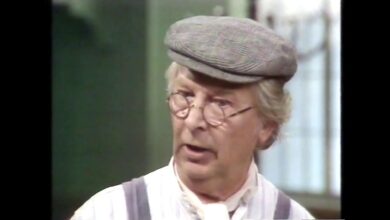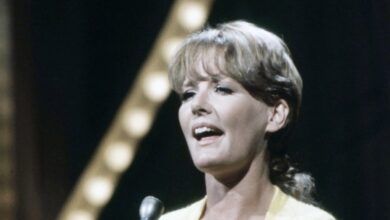George Harrison’s Timeless Classic “My Sweet Lord” Continues to Inspire Generations
Unforgettable Musical Moment: The Timeless Legacy of My Sweet Lord
In the annals of music history, few songs have achieved the profound impact and enduring legacy of George Harrison’s My Sweet Lord. Released in November 1970 as the lead single from his triple album All Things Must Pass, this track not only showcased Harrison’s deep spirituality but also marked a significant milestone in his post-Beatles career. With its spiritual themes, innovative composition, and lasting cultural influence, My Sweet Lord continues to captivate audiences across generations.
The Birth of a Spiritual Anthem
The genesis of My Sweet Lord can be traced back to December 1969, during a European tour with Delaney & Bonnie and Friends. Inspired by the Edwin Hawkins Singers’ gospel hit Oh Happy Day, Harrison sought to create a song that blended elements of gospel with his burgeoning interest in Eastern spirituality. The result was a unique fusion of Western and Eastern religious themes, seamlessly integrating the Christian Hallelujah with the Hindu mantra Hare Krishna.
A Sonic Masterpiece: Composition and Production
Musically, My Sweet Lord is a testament to Harrison’s innovative approach to songwriting. The track opens with a distinctive slide guitar riff, a technique that would become a hallmark of his solo work. The layered harmonies and Phil Spector’s “Wall of Sound” production create a rich, immersive experience that draws listeners into its spiritual message. The repetition of the lyrics enhances the meditative quality of the song, making it both an auditory and emotional journey.
Breaking Records and Winning Hearts
Upon its release, My Sweet Lord achieved remarkable commercial success. It became the first solo single by a former Beatle to reach number one on both the UK and US charts, a testament to Harrison’s individual artistry. The song’s universal appeal resonated with a wide audience, transcending cultural and religious boundaries. Its success solidified Harrison’s reputation as a serious solo artist, proving that his contributions to The Beatles extended beyond the shadow of Lennon and McCartney.
The Controversy: A Legal Battle Over Similarity
However, the song’s journey was not without controversy. In 1971, Harrison was sued for copyright infringement by Bright Tunes Music, the publisher of the 1963 Chiffons hit He’s So Fine. The court ruled that Harrison had “subconsciously” copied the earlier song, leading to a protracted legal battle that highlighted the complexities of musical inspiration and originality. While the lawsuit resulted in financial and creative frustrations for Harrison, it did little to dampen the song’s popularity.
Revived Moments in Music History
Despite the legal challenges, My Sweet Lord solidified Harrison’s reputation as a solo artist. Prior to this release, he had often been overshadowed by Lennon and McCartney’s prolific partnership within The Beatles. This song, however, showcased his ability to craft compelling melodies infused with profound spiritual themes, setting the stage for a successful solo career. His ability to merge devotion with popular music became an influential hallmark of his artistry.
A Cultural Touchstone Across Decades
The impact of My Sweet Lord on the music industry was significant. It demonstrated that mainstream audiences were receptive to songs with overt spiritual messages, paving the way for other artists to explore similar themes. The song’s fusion of different musical styles also influenced the burgeoning genre of world music, encouraging musicians to incorporate diverse cultural elements into their work. Its inclusion in various “greatest songs of all time” lists underscores its lasting influence.
Iconic Presence in Films and Social Media Revivals
Over the decades, My Sweet Lord has maintained its relevance, continually finding new audiences and reaffirming its place in the pantheon of great music. The song has been featured in numerous films and television series, including Guardians of the Galaxy Vol. 2, introducing it to a younger generation. On platforms like TikTok, snippets of the song have surfaced in nostalgic and spiritual-themed content, proving that its resonance transcends generational divides.
The Concert for Bangladesh: A Historic Performance
In live performances, My Sweet Lord took on a life of its own. Harrison’s rendition of the song at the Concert for Bangladesh in 1971 is often cited as one of his finest moments, capturing the raw energy and emotion that defined his concerts. This event, one of the first major charity concerts in history, further cemented the song’s reputation as more than just music—it became an anthem for unity and humanitarian efforts.
Influence on Future Generations of Musicians
The song’s legacy is also marked by its influence on subsequent musicians and bands. Artists across genres have cited My Sweet Lord as a source of inspiration, drawing from its innovative structure and emotive depth. Its fusion of different musical styles has encouraged others to break traditional genre boundaries, leading to more eclectic and experimental music in the years that followed.
Rediscovery Through Cover Versions
Throughout the years, many artists have covered My Sweet Lord, including Billy Preston, Elliott Smith, and Jeff Lynne. These reinterpretations highlight the song’s adaptability and continued relevance in different musical contexts. Each version brings a new dimension to the track while preserving its original spiritual essence, allowing modern audiences to connect with it in fresh ways.
A Staple in Classic Rock and Religious Gatherings
Despite its acclaim, My Sweet Lord has not been without controversy. However, its enduring popularity is evident in its continued presence in popular culture. It remains a staple on classic rock radio stations and is frequently performed in spiritual and religious gatherings, demonstrating its versatility and broad appeal. The song’s ability to bridge the sacred and the secular has ensured its longevity.
The Song’s Personal and Universal Appeal
In reflecting on My Sweet Lord, it’s clear that its magic lies in its ability to evoke a sense of wonder and introspection. Its seamless blend of musical complexity and lyrical depth invites listeners to embark on a personal journey, discovering new nuances with each listen. This timeless quality ensures that it will continue to resonate with audiences for generations to come.
Final Thoughts: A Masterpiece That Transcends Time
In conclusion, My Sweet Lord stands as a testament to George Harrison’s artistic vision and musical innovation. Its creation marked a pivotal moment in his career and in the broader landscape of rock music. Decades after its release, it remains a benchmark for musical excellence, a song that encapsulates the spirit of exploration and creativity that defines the very best of artistic endeavors. Whether heard in a moment of reflection or as part of a live performance, My Sweet Lord continues to inspire and uplift listeners around the world.
What are your thoughts on My Sweet Lord? Share your memories and experiences with this timeless track!



